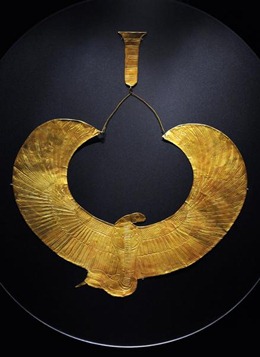Only a few days remain to ogle the 100-plus treasures on display in the Denver Art Museum's blockbuster exhibit "Tutankhamun: The Golden King and the Great Pharaohs."
 While the show's many statues and furnishings are impressive, if you love jewelry, the gold and stone pieces will leave an indelible impression.
While the show's many statues and furnishings are impressive, if you love jewelry, the gold and stone pieces will leave an indelible impression.
So-called "statement" jewelry has been on the fashion radar recently, but contemporary pieces pale in comparison to the exhibit's bold, symbol-rich collars, bracelets and rings representing 2,000 years of ancient Egyptian history.
What's striking about the designs is how so many continue to look relevant today. Scarab rings, thick cuff bracelets or gold collar necklaces are as wearable in 2011 as they were in 2600 B.C.
"It was an advanced society, and they put an emphasis on fashion," said Mark Lach, senior vice president of Arts and Exhibitions International and creative director for the Tut exhibit. "It was important to look like a king or queen. They were considered living gods."
 And they loved their golden treasures — wearing them lavishly in life and buried with them in the afterlife. "For the Egyptians, this shimmering metal had miraculous power: Gold could protect the deceased in the next life," writes Zahi Hawass in the book that accompanies the exhibit. "The bodies of the gods were made of gold; their bones were made of silver, their hair of lapis lazuli." Hawass is secretary-general of Egypt's Supreme Council of Antiquities.
And they loved their golden treasures — wearing them lavishly in life and buried with them in the afterlife. "For the Egyptians, this shimmering metal had miraculous power: Gold could protect the deceased in the next life," writes Zahi Hawass in the book that accompanies the exhibit. "The bodies of the gods were made of gold; their bones were made of silver, their hair of lapis lazuli." Hawass is secretary-general of Egypt's Supreme Council of Antiquities.
Included in the exhibit are 51 pieces from Tut's tomb, including the gold covers for the mummy's fingers and toes. They, like the other amulets found in the wrappings, were thought to provide protection. Among the most spectacular is the triple-scarab pectoral necklace that rested on his chest. Tut was buried with six pairs of earrings, and 150 items adorned his body.
Only a few of the jewelry items in the exhibit have been shown previously. The last big tour of Tut's artifacts in America was in the 1970s. Prior to that, the discovery of Tut's tomb in 1922 set off a rage for Egyptian style, said David Silverman, national curator for the Tut exhibit.
"Egyptian style comes back around periodically," he said. "People who see the exhibit want a little piece of that famous individual."
 Reproductions of jewelry and artifacts, perfumes, eye makeup, all are ways people adopt the look. (The gift shop that accompanies the exhibit feeds that demand by offering everything from Tut masks to cartouche pendants that can be custom- ordered).
Reproductions of jewelry and artifacts, perfumes, eye makeup, all are ways people adopt the look. (The gift shop that accompanies the exhibit feeds that demand by offering everything from Tut masks to cartouche pendants that can be custom- ordered).
Egyptian artisans didn't work primarily in gold because they preferred it; the metal was simply more abundant than others. "They didn't have silver as an element native to the area, so it was much more prestigious than gold," Silverman said. It's a good thing for those of us who want to see the artifacts because silver doesn't last as long and also tarnishes easily.
Also widely available and represented in much of the jewelry: feldspar and turquoise, carnelian and faience, a ceramic material craftsmen made. Lapis lazuli was imported.
As for the design of the jewelry, Silverman said, artisans "rarely left an empty space because someone would come along behind them and add their own strokes or put their name on a piece."
People today relate to the animal and nature symbology on the jewelry and statues: the birds and cats, the papyrus and lilies. "Their symbols came from the natural world, and their skill in representing them is part of the allure," Silverman said.
The symbols endure, as well. The ankh, a cross with a loop on top, signifies life. The scarab symbolizes the rising sun and renewal of life.
It's a thrill to marvel at these treasures, but exhibit organizers can't help but wonder about what got away. Silverman says there were 5,000 items in Tutankhamun's tomb.
"When we look at the jewelry we have, the majority came from what was on the mummy," he said. Experts estimate 60 percent was stolen.
Author: Suzanne S. Brown | Source: The Denver Post [January 06, 2011]